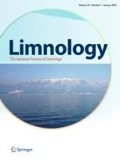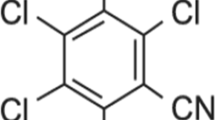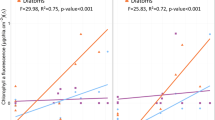Abstract
The methylthiotriazine herbicide, simetryn, is commonly used in Japan, and its concentration in surface water is often high enough to affect natural phytoplankton. To estimate how the plankton community in eutrophic systems respond to short-term exposure of realistic concentrations of simetryn, we collected plankton from a eutrophic lake and exposed them to low (20 μg l−1) and high (100 μg l−1) concentrations of simetryn for 12 days in microcosm tanks (50 l). High concentrations significantly lowered total phytoplankton biomass, particularly green algal density. Consequently, the species composition was severely modified by simetryn application. However, there was no apparent impact of simetryn on microbial food-web components, bacteria, heterotrophic nanoflagellates (HNF), and ciliates. Despite the decreased abundance of algal food, the zooplankton community showed subtle changes with simetryn application. The results indicate that the direct impact of simetryn on planktonic organisms other than phytoplankton, particularly on microbial food-web components, is weak. The indirect impact of simetryn on zooplankton through the change of food quality and quantity was also small. It has been suggested that the persistence of microorganisms, alternative food for zooplankton, probably dilutes the indirect impact of simetryn on zooplankton by compensating for the loss of food phytoplankton. Consequently, the plankton community in eutrophicated systems is resistant to the herbicide at a feasible concentration for a short period of time.




Similar content being viewed by others
References
Agasild H, Nõges T (2005) Cladoceran and rotifer grazing on bacteria and phytoplankton in two shallow eutrophic lakes: in situ measurement with fluorescent microspheres. J Plankton Res 27:1155–1174
Ahlgren G, Lundstedt L, Brett M, Forsberg C (1990) Lipid composition and food quality of some freshwater phytoplankton for cladoceran zooplankters. J Plankton Res 12:809–818
Arndt H (1993) Rotifers as predators on components of the microbial web (bacteria, heterotrophic flagellates, ciliates): a review. Hydrobiologia 255(256):231–246
Caron DA (1983) Technique for enumeration of heterotrophic and phototrophic nanoplankton, using epifluorescence microscopy, and comparison with other procedures. Appl Environ Microbiol 46:491–498
Chang KH, Nagata T, Sakamoto M, Hanazato T (2008) Day and night vertical distributions of Rotiferan and Crustacean zooplankton in Lake Suwa. J Freshwater Ecol 23:165–168
Cyr H, Pace ML (1992) Grazing by zooplankton and its relationship to community structure. Can J Fish Aquat Sci 49:1455–1465
Hanazato T (2001) Pesticide effects on zooplankton: an ecological perspective. Environ Pollut 112:1–10
Kasai F, Hanazato T (1995) Effects of the triazine herbicide, simetryn, on freshwater plankton communities in experimental ponds. Environ Pollut 89:197–202
Kibe K, Takano H, Kameya T, Urano K (2000) Estimation of runoff load of simetryn from paddy field by a new fate model. J Japan Soc Water Environ 23:343–351
Marker AFM, Nusch EA, Rai H, Riemann B (1980) The measurement of photosynthetic pigments in freshwaters and standardization of methods: conclusions and recommendations. Arch Hydrobiol Beih 14:91–106
Mohr S, Feibicke M, Berghahn R, Schmiediche R, Schmidt R (2008) Response of plankton communities in freshwater pond and stream mesocosms to the herbicide metazachlor. Environ Pollut 152:530–542
Nakano S (1996) Bacterial response to extracellular dissolved organic carbon released from healthy and senescent Fragilaria crotonensis (Bacillariophyceae) in experimental systems. Hydrobiologia 339:47–55
Nohara S, Iwakuma T (1996) Pesticide residues in water and an aquatic plant, Nelumbo nucifera, in a river mouth at Lake Kasumigaura, Japan. Chemosphere 33:1409–1416
Okamura H, Piao M, Aoyama I, Sudo M, Okubo T, Nakamura M (2002) Algal growth inhibition by river water pollutants in the agricultural area around Lake Biwa, Japan. Environ Pollut 117:411–419
Porter KG, Feig YS (1980) The use of DAPI for identifying and counting aquatic microflora. Limnol Oceanogr 25:943–948
Relyea RA (2005) The impact of insecticides and herbicides on the biodiversity and productivity of aquatic communities. Ecol Appl 15:618–627
Richards RP, Baker DB (1993) Pesticide concentration patterns in agricultural drainage networks in the Lake Erie basin. Environ Toxicol Chem 12:13–26
Sudo M, Kawachi T, Hida Y, Kunimatsu T (2004) Spatial distribution and seasonal changes of pesticides in Lake Biwa, Japan. Limnology 5:77–86
Van den Brink PJ, Ter Braak CJF (1998) Multivariate analysis of stress in experimental ecosystems by principal response curves and similarity analysis. Aquat Ecol 32:163–178
Van den Brink PJ, Ter Braak CJF (1999) Principal response curves: analysis of time-dependent multivariate responses of biological community to stress. Environ Toxicol Chem 18:138–148
Watanabe H, Nguyen MHT, Komany S, Vu SH, Asami Y, Phong TK, Tournebize J (2006) Applicability of ELISA in pesticide monitoring to control runoff of bensulfuron-methyl and simetryn from paddy fields. J Pestic Sci 31:123–129
Acknowledgments
This study was supported by Global COE program from the Japanese Ministry of Education, Culture, Sports, Science and Technology. We are grateful to Tomoki Murakami and Makoto Ishimota for their assistance during the experiment. We also thank an anonymous reviewer for valuable comments and suggestions.
Author information
Authors and Affiliations
Corresponding author
Rights and permissions
About this article
Cite this article
Chang, KH., Sakamoto, M., Ha, JY. et al. Response of the plankton community to herbicide application (triazine herbicide, simetryn) in a eutrophicated system: short-term exposure experiment using microcosms. Limnology 12, 11–16 (2011). https://doi.org/10.1007/s10201-010-0317-1
Received:
Accepted:
Published:
Issue Date:
DOI: https://doi.org/10.1007/s10201-010-0317-1




